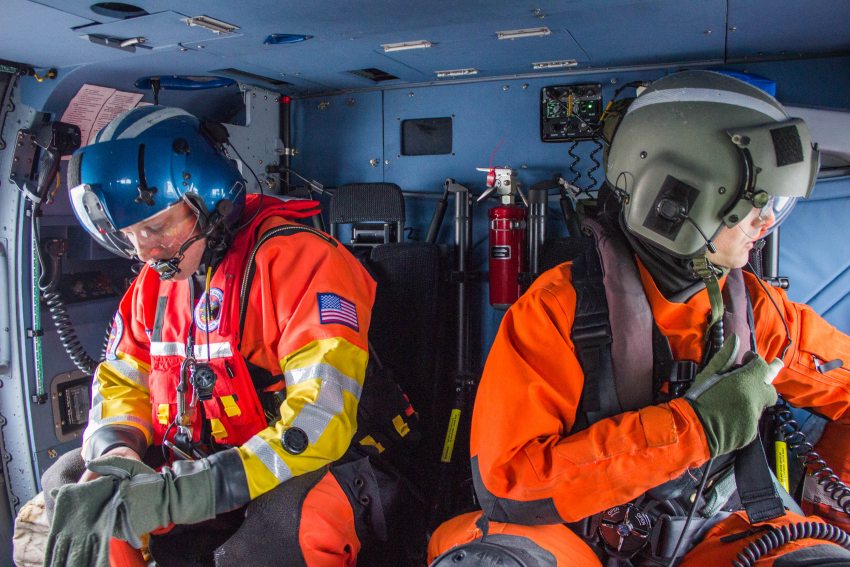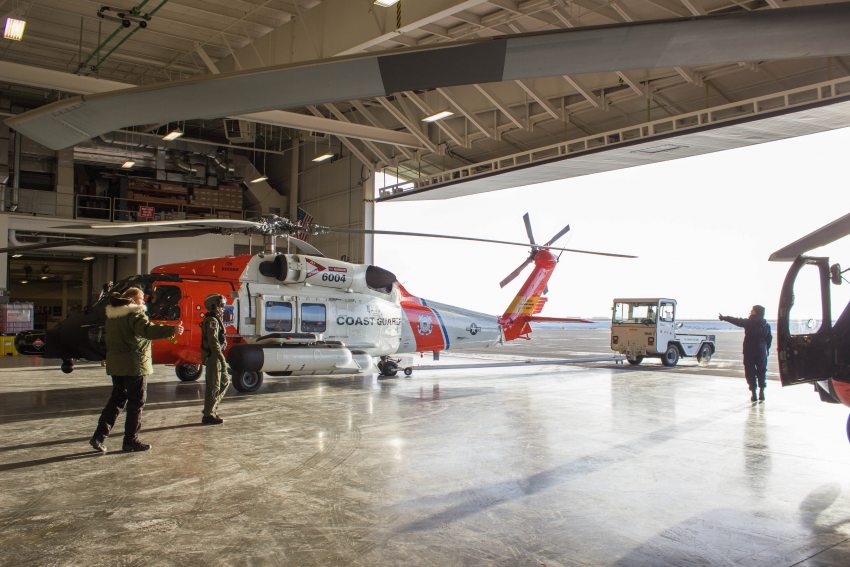U.S. Coast Guard wraps up busy Arctic season

(Asaf Shalev / Alaska Dispatch News)
DEADHORSE — Lt. Jason Evans was piloting a Coast Guard Jayhawk helicopter over the oil fields of Alaska’s North Slope when he noticed the slight movement of a whitish speck against a backdrop of snow-covered tundra.
“3 o’clock!” he shouted, his voice just barely rising above the intercom static crackling in the crew’s headsets.
Evans and his co-pilot, Lt. Joseph Plunkett, took the orange and white chopper in a large arc for another view without getting too close. In the cabin, flight mechanic Kyle Stalter adjusted a joystick for an infrared camera. A figure appeared on the device’s screen in stark black and white contrast: a lone polar bear at the edge of a frozen pond.
On search and rescue missions, the heat-detecting sensor would supplement the work of the naked eye scanning the horizon for survivors. But in the Arctic on a routine flight in October primarily for a media tour, the infrared device is being used to distinguish warm-blooded Arctic animals from their frigid environment.
Observing wildlife in their natural habitat — three polar bears and more than a dozen caribou on this flight — is one of the few perks enjoyed by the Coast Guard personnel who serve two- or three-week rotations at the temporary, seasonal base at Prudhoe Bay, near a Deadhorse runway. But there’s also an operational justification to the sightseeing activity: Knowing the location of wildlife allows pilots to divert their flight path and avoid disturbing sensitive animals.
Operation: Arctic Shield
This year, operation Arctic Shield, the Coast Guard’s catch-all designation for its work in the Arctic, began in the spring and ended earlier this month as winter set in and maritime activity came to a standstill.
Arctic Shield 2015 involved two Jayhawk helicopters stationed at a private airport hangar in Deadhorse and offshore forays into the Arctic Ocean by the polar research icebreaker Healy, the national security cutter Waesche, the high-endurance cutter Boutwell and the medium-endurance cutter Alex Haley. The vessels – and the personnel manning them – engaged in a variety of search and rescue exercises, oil spill response drills and scientific missions. The most dramatic accomplishment came Sept. 5 when the Healy reached the North Pole on a solo expedition, a first for the United States.
Strategy paper
The Coast Guard’s newfound attention to the Arctic — as melting sea ice makes increased shipping and resource exploration more feasible — started with a strategy paper issued by the agency’s Washington headquarters in 2013.
The strategy said the Coast Guard would fulfill its Arctic responsibilities by creating a “mobile” and “seasonal” presence for this “emerging maritime frontier” during the coming decade. The paper also repeated the often-heard plea for a new heavy-duty icebreaker.
Since then, “forward operating locations” — the Coast Guard’s temporary seasonal bases — have been established in Kotzebue and Barrow, and now Deadhorse. Officials say they don’t yet know the location of next year’s base and will select a site based on the availability of facilities and geographic distribution of expected maritime activity.
Rotation system good for pilot training
Coast Guard pilots, technicians and rescue swimmers arrive in forward operating locations such as Deadhorse from Air Station Kodiak and more distant installations. No one is stationed at the Arctic deployment location for an entire season — and there’s no need to, officials say.
“You can plug and play any qualified person into that framework and they will use the same language and follow the same procedures,” said Capt. Diane Durham, the chief of response at Coast Guard District 17 headquarters in Juneau.
An advantage of the rotation system, she added, is the opportunity for many pilots to develop professionally.
“The Arctic is a unique environment for pilots,” Durham said.

Preparing for increased shipping
From the arrival next year of the massive cruise ship Crystal Serenity to the uptick in solo seafarers adventuring across the Northwest Passage, two helicopters and a handful of personnel cannot alone respond to all emergency situations that may arise in the Arctic. Alaska has more than a thousand miles of Arctic coastline, and a Jayhawk’s fuel tanks allow it about six hours of airtime.
Photos: Arctic Shield 2015
Rear Adm. Daniel Abel, commander of the Coast Guard in Alaska’s Arctic, says that these land-based helicopter crews perform an important role but are supplemental.
“The primary base in the Arctic is a cutter with a helipad,” Abel said. The mobility and logistical self-sufficiency of a cutter out at sea make it a “flexible asset,” he added.
New Arctic Coast Guard Forum
The Coast Guard’s Arctic experts have entered a planning phase for next year. Some of their focus will be drawn to the Arctic Coast Guard Forum, established last week by the world’s eight Arctic nations.
“The (forum) will be an operationally-focused organization that strengthens maritime cooperation and coordination in the Arctic,” according to an emailed statement from the U.S. Coast Guard.
“The impetus for creating the (forum) grew out of the concerns of Arctic Council member countries over the increasing need to ensure safety, security, and stewardship of Arctic waters,” the statement said.
Chairmanship of the international body will rotate coinciding with that of the Arctic Council, whose membership includes Russia, Finland, Norway, Sweden, Denmark, Iceland, Canada and the United States.
Related stories from around the North:
Asia: Asia ahead on preparing for polar climate change, says U.S. Arctic rep, Eye on the Arctic
Canada: Arctic nations sign coast guard agreement, Radio Canada International
Greenland: Research ship returning from Greenland echoes worries about ocean plastics, Radio Sweden
Iceland: More Arctic research, intn’l cooperation needed, Barents Observer
Russia: Russia to open research center on Svalbard, Barents Observer
Sweden: Government to form council of researchers for sustainable development, Radio Sweden
United States: New Arctic R&D center in Alaska, Alaska Dispatch News



